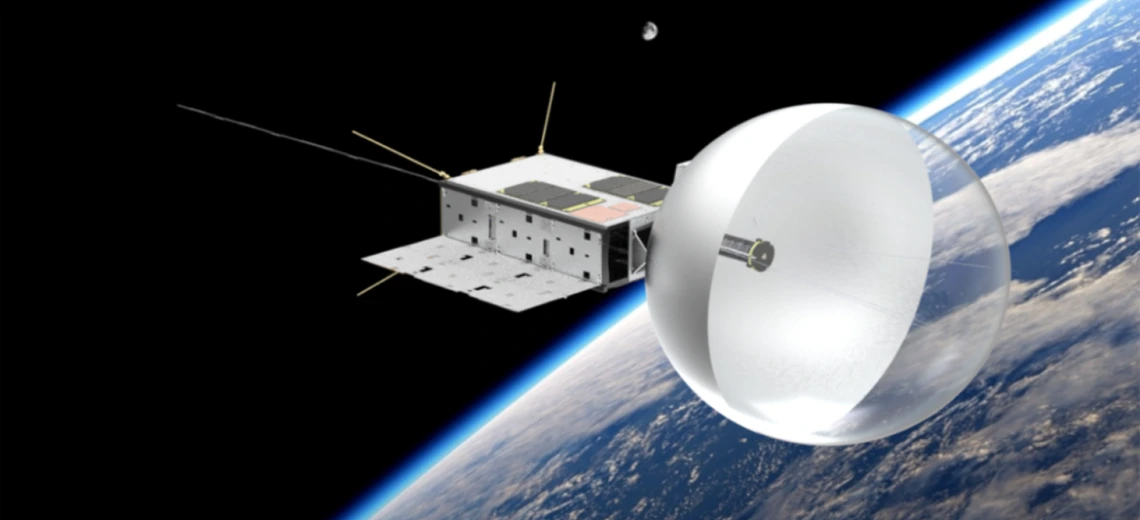Signals from student-built CatSat finally reach home

CatSat will orbit Earth about every 95 minutes for the next year, studying radio transmission in the ionosphere and testing an ultralight inflatable antenna.
Aman Chandra/FreeFall Aerospace
Shae Henley breathed a sigh of relief when technicians loaded the NASA-funded, student-built CatSat onto the commercial Firefly Aerospace Alpha rocket on June 29 for its ride into low-earth orbit.
The mission was part of NASA’s CubeSat Launch Initiative to foster growth in the small-sat industry. UA tech spinoff FreeFall Aerospace and Tucson-based Rincon Research partnered on the project.
“It has been the most helpful thing at the university,” said Henley, an aerospace engineering master's student who has worked on the satellite since her first year as an undergraduate at the University of Arizona. “Classes give you a solid math and physics background but not necessarily hands-on experience.”
Henley drove back to Tucson from the Vandenberg Space Force Base in California while Firefly prepared the rocket for its two-days-delayed launch on July 3.
As Henley stood in crowd cheering at the sight of the rocket’s plume across the sky above the UA mall, she and the dozen or so undergraduate and graduate students who built CatSat over four years ago had no way of knowing the wait still was not over.
U.S. Space Force tracking accounted for seven of the eight nanosatellites scheduled for deployment from the spacecraft. But not a sound from CatSat. The team listened for signals from their tiny craft for nearly two weeks. They were afraid their satellite was stuck in the rocket, and they’d never hear from it again.
“We didn’t hear anything for a long time,” Aman Chandra, the project’s lead mechanical engineer, told the Arizona Daily Star.
Chandra, a senior engineer at Freefall Aerospace, designed and built CatSat’s inflatable antenna while earning his PHD at the university.
Finally, as the sun dipped below the horizon on July 15, the team began receiving telemetry data, and Firefly confirmed the satellite’s deployment.
It was like it had suddenly risen from the dead, said Chandra.
CatSat’s mission is to orbit earth once about every 95 minutes for the next six months to a year, collecting ionospheric data and testing the inflatable antenna.
Amateur, or ham, radio enthusiasts take advantage of this charged layer of the atmosphere to broadcast information throughout the world. The team hopes to provide information that will improve ham radio transmissions. The inflatable antenna is expected to dramatically increase the total data return, including high-definition imagery in real time, and overall effectiveness of CubeSats and other small satellites.
Night and day differences
The approximately 20-pound satellite about the size of a cereal box has three optical sensors — one camera to take high-resolution images of Earth, another to navigate by the stars, and a low-resolution sensor to monitor the antenna.
The idea of an inflatable antenna for nanosatellites originated with Freefall Aerospace cofounder Chris Walker – UA professor of astronomy and Chandra’s thesis adviser.
“With an inflatable antenna, you can pack a 10-foot antenna inside a 2-foot space,” said the project’s principal investigator.
The antenna is inflated with a gas mix to 20 inches around. A silver coating on half of the otherwise clear device forms a mirror to reflect and concentrate signals.
Because spacecraft in low-earth orbit encounter forces that can affect their trajectories, CatSat is using a more traditional whip antenna, which looks like a 2-foot long protruding stick, to ensure data collection and transmission before deploying and testing the beach-ball like antenna.
“There’s some residual atmosphere in that part of space,” explained Henley. “There will still be drag due to the inflatable antenna’s larger size. So, we want to get some good ionospheric data beforehand.”
Better ham radio capabilities
The team is investigating how charged particles in the ionosphere, one of the uppermost layers of Earth’s atmosphere, fluctuate with solar activity from day to night, affecting ham radio transmission.
“Radio wave transmission is affected by the time of day because particles in the ionosphere get charged by the sun’s energy,” explained Walker.
Thousands of Earthbound amateur radio enthusiasts use the approximately 20 existing ham radio satellites for communications, technology development and ionospheric propagation studies. The bulkier satellites have for decades functioned like steppingstones as high frequency radio signals bend around the Earth, bounce off the ionosphere and travel to far-reaching locations. In contrast, CatSat receives and transmits high frequency radio signals, so ham radio users can actually talk through the satellite.
The CatSat team plans to make the results of its experiments publicly accessible to amateur radio operators.
“We are providing a service to the global ham radio community,” Walker said.
